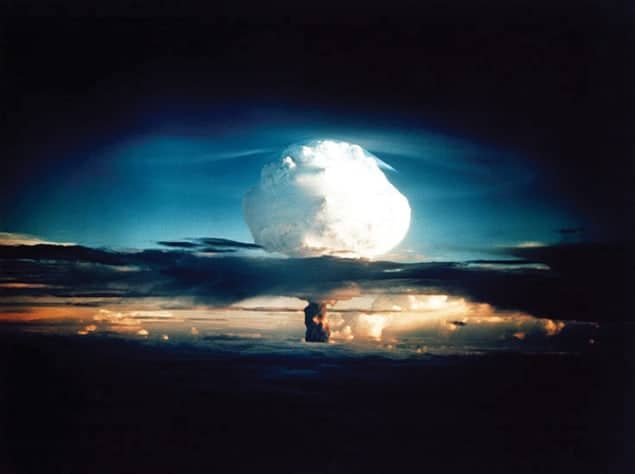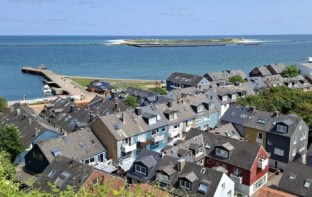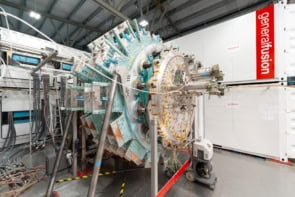Richard Moore reviews Building the H Bomb: a Personal History by Kenneth W Ford

Ken Ford is one of the very few surviving witnesses to the birth of the US hydrogen bomb. His book, mixing physics and history with personal memoir, has been received with great interest, partly because of a dispute with the US Department of Energy (DOE) over classification. In summary, the DOE didn’t want you to read parts of Ford’s book, although the author states plainly that it “contains nothing whose dissemination could possibly harm the United States or help some other country seeking to design and build an H-bomb”. Indeed, although his account of bomb design is detailed and intriguing, readers will find it consistent with several others in the public domain.
Ford explains that he was persuaded to join the nuclear weapons research laboratory at Los Alamos in 1950 by the physicists John Wheeler (who was, at the time, his PhD supervisor at Princeton University) and Edward Teller. Wheeler and Teller felt the pressure of Cold War rivalry keenly, and Teller in particular was the H-bomb’s greatest enthusiast. Ford, on the other hand, appears to have been charmingly naive: “At the time politics, like professional sports, were outside the range of my interests. Yet I had a general feeling that it would be a good thing if teams from Boston won their games and if the United States acquired an H-bomb before the Soviet Union.”
But the race for the new weapon – many times greater in destructive power than the existing atomic bomb – was not going well. The key challenge was to use a fission atomic bomb to ignite and sustain a fusion reaction in heavy hydrogen, and since the Second World War, Los Alamos scientists had been pursuing (with more or less enthusiasm) a plan for doing this based on a design known as the “classical Super” or “runaway Super”. But calculations showed more and more conclusively that too much energy would be lost: the classical Super wouldn’t work. Then, in February 1951, a conversation between Teller and fellow scientist Stanis?aw Ulam suggested a new direction. Radiation from the fission bomb, if confined and channelled correctly, could implode the fusion fuel, compressing it sufficiently to sustain a reaction yielding enormous amounts of energy. This new “equilibrium Super” idea led to success.
The relative contributions of Teller and Ulam have been hotly disputed, and Ford gives a clear and sympathetic account of claim and counter-claim. In many popular versions of the story, the driven Teller is the arch-villain. Ford, however, recognizing that Teller and Ulam “were not soul mates”, got on with both men. Perhaps as a result, he is refreshingly even-handed. (Although Teller, surely, deserves most of the credit for America’s H-bomb, if only for the sheer force of will with which he kept the programme alive.)
Ford goes on to describe his contribution to modelling calculations ahead of the test of the “Ivy Mike” thermonuclear device in November 1952. Here and elsewhere, Ford’s account is vivid and appealing, illustrating the informality and also the uncertainty of the work. Personal memories are the book’s greatest strength. In one such anecdote, Ford describes Wheeler writing and drawing on a blackboard simultaneously and ambidextrously. He tells us about job offers made without much thought to budgets or authorizations. He describes falling in love with the New Mexico countryside, hiking and driving at weekends, and watching Teller and Nobel laureate Enrico Fermi “fiercely” playing Parcheesi (the American equivalent of Ludo).
Upon moving back to Princeton in 1951, Ford found his office located in a corrugated metal shack that had previously housed laboratory animals. When the potential of slide-rules and “computers” (junior, generally female laboratory staff employed for number-crunching and drawing up spreadsheets in long-hand) was exhausted, Ford needed time on the cutting-edge IT of the day. The MANIAC computer at Princeton itself was “a prototype Aston Martin … fast, sleek … and unreliable” and thus not good enough for work on the H-bomb. For parts of 1951 and 1952, therefore, Ford put in long night shifts with other electronic computers, first at an IBM office in New York, then at the Bureau of Standards in Washington, DC. Here, having cautiously checked the first calculations made on the SEAC computer by hand, he became a fan: “I gained a true affection for the SEAC…my night-time companion for the many weeks of a long hot summer.” The likely progress of the fusion reaction could be modelled only in one dimension at a time, either radially or axially, and Ford was well pleased when his prediction for the yield of the Ivy Mike device was within 30% of the observed figure.
The Ivy Mike test, Ford writes, “produced in me that odd combination of euphoria and dread that other nuclear weaponeers have no doubt also experienced”. Following the test, he returned to his PhD dissertation and never worked on nuclear weapons again. Many years later, disillusioned by the Vietnam War, he announced his unwillingness to return to any secret work, although in 1968 he found himself back at Los Alamos doing unclassified research. By this time, he had enough children to qualify for housing with a fitted bathtub, and he lived next door to Ulam and his family on so-called “Bathtub Row”.
Ford doesn’t glorify, or apologize for, his work on the H-bomb. He simply tells it as it was. As a result, this is an engagingly human glimpse into the world of physics in the US in the early 1950s.
- 2015 World Scientific £38/$58hb £16/$24pb 250pp



